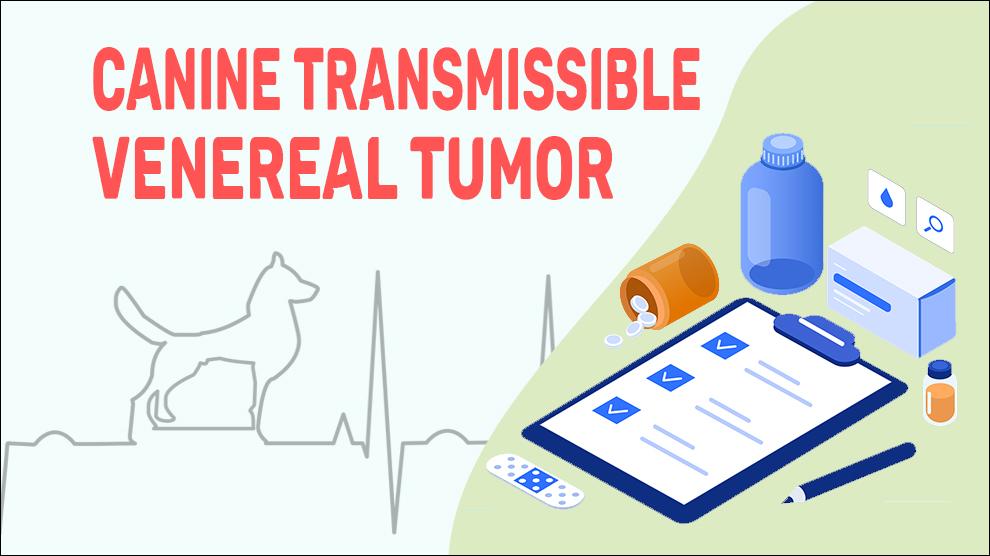What is Canine Transmissible Venereal Tumor?
A canine transmissible venereal tumor (CTVT) is the allogeneic transmission of whole neoplastic cells from one dog to another during coitus which often results in irritation of tissues and so facilitates the spread of the malignant cells.
This sexually transmitted tumor is nodular, cauliflower-like, poorly circumscribed, pedunculated, multilobulated or papillary, friable, ulcerated, and hemorrhagic in appearance. The sizes range from 5 mm (small nodules) to >10 cm (large mass). The ulcerated surface gets often inflamed and there will be bleeding. TVT neoplasms may be single or multiple and are almost always located on the external genitalia but can also be found in other locations, including the Lymph nodes, mouth and nasal cavity.
This can occur in both sexes with a low occurrence of metastasis. The etiology of CTVT is said to be histiocytic, reticuloendothelial, or lymphatic, while the latest reports suggest a myeloid or macrophage origin.
These parasitic cancer clone cells do not resemble cells of canine origin, having a strange karyotype of 56–59 chromosomes (of which 40 or 42 are acrocentric), however, the normal chromosome number is 78 in dogs (only 2 are acrocentric). This somatic cell line is assumed to be the oldest identified continuously propagating somatic cell lineage in post-domestication canid and it has been assumed to have manifested between 7,000 and 12,000 years ago (the precise date is still disputed).
Canine transmissible venereal tumors are also called infectious sarcoma, Sticker's sarcoma, venereal granuloma, canine transmissible venereal sarcoma (CTVS), and transmissible lymphosarcoma.
Symptoms Of Canine Transmissible Venereal Tumor
Symptoms depend on the location of the tumor.
- Males: Bloody discharge from the penis.
- Females: Bloody discharge from vaginal areas.
- Uneven thickening of the tissue, intermittent bleeding, or bruising in the vulva.
- ‘cauliflower-like’ nodules in mouth or tongue.
Treatment Options For Canine Transmissible Venereal Tumor
- Surgical options, radiation, chemotherapy, or a combination of these modalities may be tried.
- For advanced tumors, surgery is the only option followed by chemotherapy.
- Radiotherapy may be used to shrink cancerous cells prior to surgery or used post-op to reduce the duration of the resulting remission.
- Newer treatment protocols such as immunotherapy, Targeted drug therapy, and monoclonal antibodies are also available.
Home Remedies For Canine Transmissible Venereal Tumor
- After surgery, Dog activities should be restricted activity for about 2 weeks to allow recovery and incision healing.
- A restrictive collar usage is recommended for 10-14 days. This prevents the natural tendency of dogs to lick and chew at a wound.
- A diet of roughly 50% meat and 40–50% whole grains or non-starchy vegetables is optimal.
- A homemade balanced diet is an alternative to commercial diets.
- Fish oils or fish meals, or whole fish are rich in omega-3 fatty acids.
How to Prevent Canine Transmissible Venereal Tumor?
- Unlike other malignancies that originate from the host’s own cells, Dogs that have been diagnosed with TVT most likely contracted it from another dog.
- CTVT is essentially a transmissible allograft spread of infectious histiocytic tumor from one dog to another.
- Until your veterinarian determines that treatment successfully cures the tumor, contact with other dogs should be avoided.
- These tumors can ulcerate, and becomes hemorrhagic with recurrent necrosis and superficial bacterial infection.
- When your pet is diagnosed with a TVT, treatment should be promptly done, both to avoid the transmission of the disease to other dogs and the risk of metastasis although it is rare.
Affected Dog Breeds Of Canine Transmissible Venereal Tumor
Additional Facts For Canine Transmissible Venereal Tumor
- Causes:
- Sexual Intercourse
- Direct contact with the infected tumor, such as by licking, sniffing, scratching, or orbiting.
- Childbirth
- Mother to puppies through grooming.
- Stages:
Three distinct growth phases are identified in Experimental transplantation studies.
- Progressive Stage
- Static Stage
- Regressive Stage
After progressive growth of 2 - 4 months, the tumor regresses in the experimental studies. Presumably, Lymphocyte-mediated cytotoxicity (infiltration) occurs in some naturally acquired cases and results in spontaneous regression of tumors within 3 months after implantation.
- Diagnosis:
- Complete blood count (CBC), Blood chemistry profile
- Electrolyte panel
- Urinalysis/ Faecal analysis
- Vaginoscopy
- Fine needle aspiration, surgical excision, or punch biopsy
- X-rays and ultrasounds
- Mortality:
CTVT is curable in most cases and is generally not fatal. The host dog’s tumor-specific host immune response clears or controls the tumor after a phase of progression.
- Prognosis:
The prognosis for CTVT is really good. As the existing condition is not life-threatening, no rigorous treatment is usually necessary. However, relapse is possible in 90% of cases following medical treatment in affected dogs. Proper hygiene and home care are the best defenses against future recurrences.
When To See A Vet For Canine Transmissible Venereal Tumor
Time to visit the vet clinic for an examination, if you notice any of the following:
- Males: Bloody discharge from the penis.
- Females: Bloody discharge from vaginal areas.
Dog Food Suggestions For Canine Transmissible Venereal Tumor
- High Protein, Good Fats and Low Carbs, antioxidants, and cancer-fighting
- Dogs: 50% veggies (dark leafy greens, carrots, broccoli, green beans, etc are good choices) + 50% protein (chicken or beef is best).
- Fresh, lean protein (Lean ground beef, White-meat skinless chicken, or turkey).
- Vitamin-rich fruits and veggies: Legumes, such as lentils, peas or beans, cauliflower, cabbage, broccoli, tomatoes, and citruses, such as oranges and limes.
Conclusion
The most favorable prognosis can be expected with early detection and appropriate treatment. This emphasizes the significance of a genital examination as part of a routine physical examination in all dogs.
Spontaneous regression of tumors happens in some cases without treatment. There is also a 90% chance of complete remission even with the right treatment.
Sometimes, the tumors metastasize to internal organs and this may lead to further complications that can compromise recovery.

















